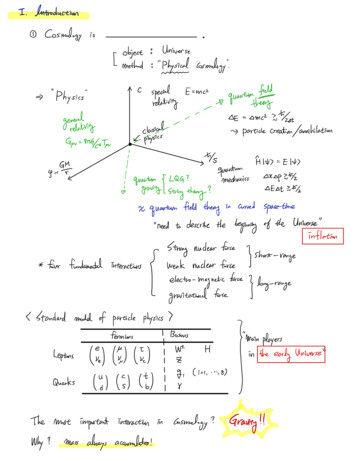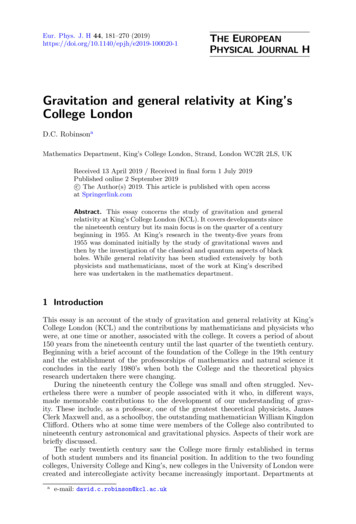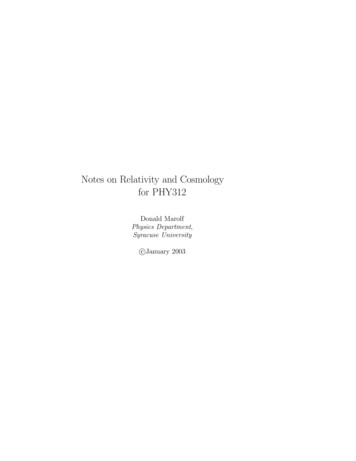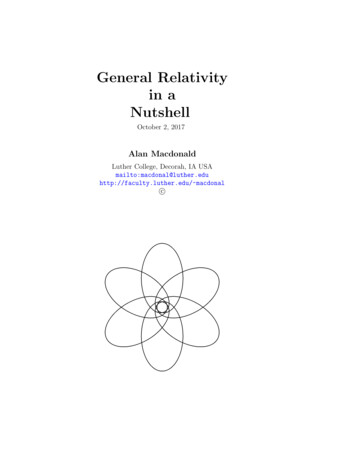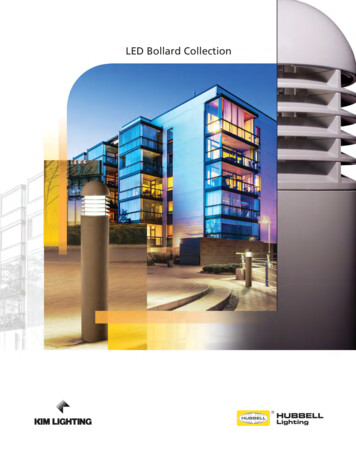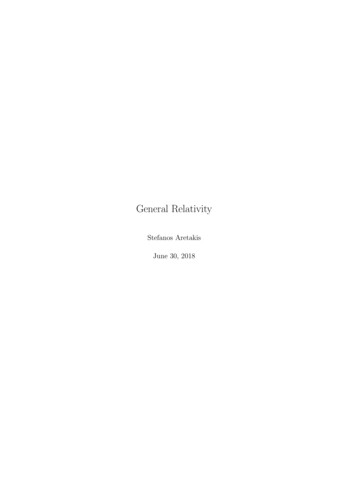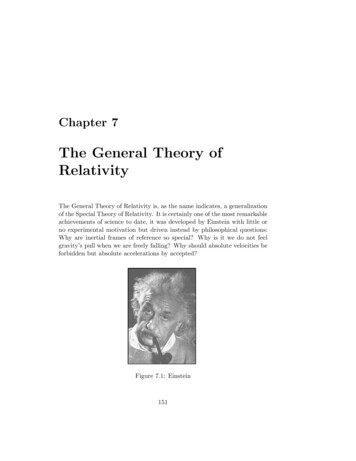
Transcription
Chapter 7The General Theory ofRelativityThe General Theory of Relativity is, as the name indicates, a generalizationof the Special Theory of Relativity. It is certainly one of the most remarkableachievements of science to date, it was developed by Einstein with little orno experimental motivation but driven instead by philosophical questions:Why are inertial frames of reference so special? Why is it we do not feelgravity’s pull when we are freely falling? Why should absolute velocities beforbidden but absolute accelerations by accepted?Figure 7.1: Einstein151
1527.1The happiest thought of my life.In 1907, only two years after the publication of his Special Theory of Relativity, Einstein wrote a paper attempting to modify Newton’s theory ofgravitation to fit special relativity. Was this modification necessary? Mostemphatically yes! The reason lies at the heart of the Special Theory of Relativity: Newton’s expression for the gravitational force between two objectsdepends on the masses and on the distance separating the bodies, but makesno mention of time at all. In this view of the world if one mass is moved,the other perceives the change (as a decrease or increase of the gravitationalforce) instantaneously. If exactly true this would be a physical effect whichtravels faster than light (in fact, at infinite speed), and would be inconsistent with the Special Theory of Relativity (see Sect. 6.2.7). The only wayout of this problem is by concluding that Newton’s gravitational equationsare not strictly correct. As in previous occasions this does not imply thatthey are “wrong”, it only means that they are not accurate under certaincircumstances: situations where large velocities (and, as we will see, largemasses) are involved cannot be described accurately by these equations.In 1920 Einstein commented that a thought came into his mind whenwriting the above-mentioned paper he called it “the happiest thought of mylife”:The gravitational field has only a relative existence. Because foran observer freely falling from the roof of a house – at leastin his immediate surroundings – there exists no gravitationalfield.Let’s imagine the unfortunate Wile E. Coyote falling from an immenseheight 1 . As he starts falling he lets go of the bomb he was about to dropon the Road Runner way below. The bomb does not gain on Wile nor doesit lag behind. If he were to push the bomb away he would see it move withconstant speed in a fixed direction. This realization is important becausethis is exactly what an astronaut would experience in outer space, far awayfrom all bodies (we have good evidence for this: the Apollo 10–13 spacecraftsdid travel far from Earth into regions where the gravitational forces are quiteweak).Mr. Coyote is fated to repeat the experience with many other things:rocks, magnets, harpoons, anvils, etc. In all cases the same results areobtained: with respect to him all objects, irrespective of composition, mass,1I ignore air resistance
153etc. behave as if in free space. So, if he should fall inside a closed box, hewould not be able to tell whether he was plunging to his death (or, at least,severe discomfort), or whether he was in outer space on his way to Pluto atconstant speed.This is reminiscent of Galileo’s argument: the observer lets go of someobjects which remain in a state of uniform motion (with respect to him!).This behavior is independent of their chemical or physical nature (as above,air resistance is ignored). The observer (Wile), as long as he confines his/herobservations to his/her immediate vicinity (that is, as long as he/she doesnot look down) has the right to interpret his state as ‘at rest’. Just asGalileo argued that experiments in a closed box cannot determine the stateof uniform motion of the box, Einstein argued that experiments in a freelyfalling small2 closed box cannot be used to determine whether the box is inthe grip of a gravitational force or not.Why would this be true? The answer can be traced back to the way inwhich gravity affects bodies. Remember (see Sect. 4.3.3) that the quantitywe called m (the mass) played two different roles in Newton’s equations.One is to determine, given a force, what the acceleration of the body wouldbe: F ma (the inertial mass). The other is to determine the intensitywith which the said body experiences a gravitational force: F mM G/r2(the gravitational mass). As mentioned before these two quantities need notbe equal: the first “job” of m is to tell a body how much to accelerate givenany force, a kick, an electric force (should the body be charged), etc. Thesecond “job” tells the body how much of the gravitational force should itexperience and also determines how strong a gravitational force it generates.But, in fact, both numbers are equal (to a precision of ten parts per billion).What does this imply? Well, from Newton’s equations we getmM G ma so thatr2MG a;r2this equation determines how a body moves, which trajectory it follows,how long does it take to move from one position to another, etc. and isindependent of m! Two bodies of different masses, composition, origin andguise will follow the same trajectory: beans, bats and boulders will move inthe same way.So the equality of the two m’s was upgraded by Einstein to a postulate:the Principle of Equivalence; this one statement (that the m in ma andthe m in mM G/r2 are identical) implies an incredible amount of new and2The reasons behind the requirement that the box be small will become clear soon.
154The m in F ma iscalled the inertial massand the m in mM G/r 2the gravitational massThe inertial andgravitational masses areidenticalsurprising effects. The m in F ma is called the inertial mass and the m inmM G/r2 the gravitational mass. Then the Principle of Equivalence statesthat the inertial and gravitational masses are identical.The whole of the General Theory of Relativity rests on this postulate,and will fail if one can find a material for which the inertial and gravitational masses have different values. One might think that this represents adefect of the theory, its Achilles heel. In one sense this is true since a singleexperiment has the potential of demolishing the whole of the theory (peoplehave tried.hard, but all experiments have validated the principle of equivalence). On the other hand one can argue that a theory which is based on aminimum of postulates is a better theory (since there are less assumptionsinvolved in its construction); from this point of view the General Theory ofRelativity is a gem 3 .The completed formulation of the General Theory of Relativity was published in 1916 (Fig. 7.2).Figure 7.2: Einstein’s General Theory of Relativity paper.3The Special Theory of Relativity is equally nice, it is based on the one statement thatall inertial frames of reference are equivalent.
1557.1.1Newton vs. EinsteinI have stated that Newton’s mechanics and his theory of gravitation are butapproximations to reality and whose limitations are now known 4 . So itmight be questionable to use F ma and Fgrav mM G/r2 as basis to anyargument as was done above. Einstein was careful to use these expressionsonly in situations where they are extremely accurate (small speeds compared to c and small gravitational forces). In these cases the inertial andgravitational masses are identical, as shown by experiment. Then he postulated that the same would be true under all circumstances. This statement,while consistent with Newton’s equations, cannot, in a strict logical sense,be derived from them.7.2Gravitation vs accelerationConsider the following experiment: a person is put in a room-size box highabove the moon (chosen because there is no air and hence no air friction)with a bunch of measuring devices. This box is then taken high above thelunar surface and then let go: the box is then freely falling. The questionis now, can the observer determine whether he/she is falling or whetherhe/she is in empty space unaffected by external forces (of course the answeris supposed to come before the box hits the surface). The answer to that isa definite NO! The observer can do experiments by looking at how objectsmove when initially at rest and when given a kick, he/she will find that theyappear to move as is there were no gravitational forces at all! Similarly anyexperiment in physics, biology, etc. done solely inside the box will be unableto determine whether the box is freely falling or in empty space.Why is that? Because of the equality of the gravitational and inertialmasses. All objects are falling together and are assumed to be rather closeto each other (the box is not immense) hence the paths they will follow willbe essentially the same for each of them. So if the observer lets go of anapple, the apple and the observer follow essentially the same trajectory, andthis implies that the observer will not see the apple move with respect tohim. In fact, if we accept the priniciple of equivalence, nothing can be doneto determine the fact that the observer is falling towards the Moon, for thiscan be done only if we could find some object which behaved differently fromall the rest, and this can happen only if its gravitational and inertial masses4For all we know our present theories of mechanics and gravitation may also be invalidunder certain conditions.
156are different. The principle of equivalence then implies that the observerwill believe that he/she is an inertial frame of reference.until disabused ofthe notion by the crash with the surface.The principle of equivalence is of interest neither because its simplicity,nor because it leads to philosophically satisfying conclsions. It’s importanceis based on the enormous experimental evidence which confirms it; as withthe Special Theory, the General Theory of Relativity is falsifiable.Figure 7.3: An observer cannot distinguish between acceleration producedby a rocket and the acceleration produced by gravity.For any gravitational forcewe can always choose aframe of reference in whichan observer will notexperience any gravitationaleffects in his/her immediatevicinityThe lesson is that for any gravitational force we can always choose aframe of reference in which an observer will not experience any gravitationaleffects in his/her immediate vicinity (the reason for this last qualificationwill become clear below). Such a frame of reference is, as stated above,
157freely falling.Conversely one can take the box an attach it to a machine that accelerates it (Fig. 7.3). If an observer drops an apple in such an acceleratedbox he/she will see the apple drop to the floor, the observer will also feelhi/her-self pressed against the bottom of the box, etc. The observer cannot distinguish between this situation and the one he/she would experiencein the presence of gravitational forces! As long as we do experiments in asmall region, the effects produced by a gravitational force are indistinguishable from those present in an accelerated reference frame.Does this mean that the gravitational forces are a chimera, an illusion?Of course no. Consider for example Fig. 7.4, two apples fall to the Mooninside a box which is also falling. If they are separated by a sufficientlylarge distance an observer falling with the apples and box will find that thedistance between the apples shortens as time goes on: this cannot be aninertial frame he argues (or else it is, but there is some force acting on theapples).This same set-up can be used to distinguish between a box under theinfluence of a gravitational force and one being pulled by a machine; againwe need a very big box (planet-sized). An observer places an two apples atthe top of the box and releases them, he/she carefully measures its initialseparation. The apples fall to the bottom of the box and the observermeasures their separation there. If it is the same as above, and is the sameirrespective of their initial separation, the observer is being pulled by amachine (box and all). If the separation is different, he/she can concludethat he/she is experiencing the effects of a gravitational force.7.3LightA very surprising corollary of the above is that light paths are bent bygravitational forces! I will argue this is true in a slightly round-about way.Consider an elevator being pulled by a crane so that it moves with constant acceleration (that is its velocity increases uniformly with time). Suppose that a laser beam propagating perpendicular to the elevator’s directionof motion enters the elevator through a hole on the left wall and strikes theright wall. The idea is to compare what the crane operator and the elevatorpassenger see.The crane operator, who is in an inertial frame of reference, will see thesequence of events given in Fig. 7.5. Note, that according to him/her, lighttravels in a straight line (as it must be since he/she is in an inertial frame!).In a small region the effectsproduced by a gravitationalforce are indistinguishablefrom those present in anaccelerated reference frame
158Figure 7.4: Experiment that differentiates between a gravitational effect andthe effects of uniform acceleration: for an observer in the box the apples willdraw closer.Light light paths are curvedby gravityThe elevator passenger will see something very different as shown in Fig.7.5: the light-path is curved! Thus for this simple thought experiment lightpaths will be curved for observers inside the elevator.Now we apply the equivalence principle which implies that we cannotdistinguish between an elevator accelerated by a machine and an elevatorexperiencing a constant gravitational force. It follows that the same effectshould be observed if we place the elevator in the presence of a gravitationalforce: light paths are curved by gravityThat gravity affects the paths of planets, satellites, etc. is not somethingstrange. But we tend to think of light as being different somehow. The aboveargument shows that light is not so different from other things and is indeedaffected by gravity in a very mundane manner (the same elevator experimentcould be done by looking at a ball instead of a beam of light and the same
159Figure 7.5: Left: sequence of events seen by an crane operator lifting anelevator at constant acceleration (the speed increases uniformly with time).The short horizontal line indicates a laser pulse which, at the initial time,enters through an opening on the left-hand side of the elevator. At thefinal time the light beam hits the back wall of the elevator. Right: samesequence of events seen by a passenger in an elevator being hoisted by acrane. The line joining the dots indicates the path of a laser which, at theinitial time, enters through an opening on the left-hand side of the elevator.At the final time the light beam hits the back wall of the elevator.sort of picture would result).A natural question is then, why do we not see light fall when we ridean elevator? The answer is that the effect in ordinary life is very small.Suppose that the height of the elevator in Fig. 7.5 is 8 ft. and its widthis 5 ft; if the upward acceleration is 25% that of gravity on Earth then thedistance light falls is less than a millionth of the radius of a hydrogen atom(the smallest of the atoms). For the dramatic effect shown in the figurethe acceleration must be enormous, more than 1016 times the accelerationof gravity on Earth (this implies that the passenger, who weights 70 kg onEarth, will weigh more than 1,000 trillion tons in the elevator).
160This does not mean, however, that this effect is completely unobservable(it is small for the case of the elevator because elevators are designed forvery small accelerations, but one can imagine other situations). Considerfrom example a beam of light coming from a distant star towards Earth(Fig. 7.6) which along the way comes close to a very massive dark object.The arguments above require the light beam to bend; and the same thingwill happen for any other beam originating in the distant star. Suppose thatthe star and the opaque object are both prefect spheres, then an astronomeron Earth will see, not the original star, but a ring of stars (often called an“Einstein ring). If either the star or the massive dark object are not perfectspheres then an astronomer would see several images instead of a ring (Fig.7.7). This effect has been christened gravitational lensing since gravity actshere as a lens making light beams converge.Figure 7.6: Diagram illustrating the bending of light from a star by a massivecompact object. If both the bright objects and the massive object are prefectsphere, there will be an apparent image for every point on the “Einsteinring”.How do we know that the multiple images which are sometimes seen (Fig.7.7) are a result of the bending of light? The argument is by contradiction:
161Figure 7.7: The Einstein Cross: four images of a quasar GR2237 0305 (avery distant – 8 billion light-years–, very bright object) appear around thecentral glow. The splitting of the central image is due to the gravitationallensing effect produced by a nearby galaxy. The central image is visiblebecause the galaxy does not lie on a straight line from the quasar to Earth.The Einstein Cross is only visible from the southern hemisphere.suppose they are not, that is suppose, that the images we see correspond todifferent stars. Using standard astronomical tools one can estimate the distance between these stars; it is found that they are separated by thousandsof light years, yet it is observed that if one of the stars change, all the othersexhibit the same change instantaneously! Being so far apart precludes thepossibility of communication between them; the simplest explanation is theone provided by the bending of light. It is, of course, possible to ascribethese correlations as results of coincidences, but, since these correlationsare observed in many images, one would have to invoke a “coincidence” forhundreds of observations in different parts of the universe.The bending of light was one of the most dramatic predictions of theGeneral Theory of Relativity, it was one of the first predictions that wereverified as we will discuss below in Sect. 7.12.
1627.4Clocks in a gravitational force.When comparing a clock under the influence of gravitational forces with onevery far from such influences it is found that the first clock is slow comparedto the second. To see this consider the same clock we used in the SpecialTheory of Relativity. For this experiment, however, imagine that the clockis being accelerated upward, being pulled by a crane. The clock gives off ashort light pulse which moves towards the mirror at the top of the box, atthe same time the mirror recedes from the pulse with even increasing speed(since the box accelerates). Still the pulse eventually gets to the mirrorwhere it is reflected, now it travels downward where the floor of the box ismoving up also with ever increasing velocity (see Fig. 7.8).Figure 7.8: An accelerated clock. The circle denotes a pulse of light whichat the initial is sent from a source; after a time it reaches the top of the thebox and is reflected. The time it takes to do the trip is longer than for aclock at rest.On the trip up the distance covered by light is larger than the height
163of the box at rest, on the trip down the distance is smaller. A calculationshows that the whole distance covered in the trip by the pulse is larger thantwice the height of the box, which is the distance covered by a light pulsewhen the clock is at rest.Since light always travels at the same speed, it follows that the time ittakes for the pulse to go the round trip is longer when accelerating thanwhen at rest: clocks slow down whenever gravitational forces are present.This has an amazing consequence: imagine a laser on the surface ofa very massive and compact planet (so that the gravitational field is verystrong). An experimenter on the planet times the interval between two crestsof the laser light waves and gets, say, a millionth of a second. His clock ,however, is slow with respect to the clock of an observer far away in deepspace, this observer will find that the time between two crests is larger. Thisimplies that the frequency of the laser is larger on the planet than in deepspace: light leaving a region where gravity is strong reddens. This is calledthe gravitational red-shift (see Fig. 7.9).Figure 7.9: The gravitational redshidft. Since clocks slow down in a stronggravitational field then light, whose oscillations can be used as clocks, willbe shifter towards the red as it leaves a region where gravity is strong.As for time dilation, the slowing down of clocks in the presence of gravitational forces affects all clocks, including biological ones. A twin trveling toLight leaving a region wheregravity is strong reddens
164a region where gravity is very strong will come back a younger than the twinleft in a rocket in empty space. This is an effect on top of the one producedby time dilation due to the motion of the clocks. The gravitational forcesrequired for a sizable effect, however, are enormous. So the twin will returnyounger.provided she survives.7.5Black holesSo gravity pulls on light just as on rocks. We also know that we can putrocks in orbit, can we put light in orbit? Yes! but we need a very heavyobject whose radius is very small, for example, we need something as heavyas the sun but squashed to a radius of less than about 3km. Given such anobject, light moving towards it in the right direction will, if it comes closeenough land in an orbit around it. If you place yourself in the path of lightas it orbits the object, you’d be able to see your back.But we can go farther and imagine an object so massive and compactthat if we turn on a laser beam on its surface gravity’s pull will bend itback towards the surface. Think what this means: since no light can leavethis object it will appear perfectly black, this is a black hole. An objectwhich comes sufficiently close to a black hole will also disappear into it(since nothing moves faster than light if an object traps light it will alsotrap everything else).The effect of a black holes, like all gravitational effects, decreases withdistance. This means that there will be a “boundary” surrounding the blackhole such that anything crossing it will be unable to leave the region nearthe black hole; this boundary is called the black-hole horizon see Fig. 7.10Anything crossing the horizon is permanently trapped. Black holes areprefect roach motels: once you check in (by crossing the horizon), you nevercheck out.The distance from the black hole to the horizon is determined by themass of the black hole: the larger the mass the mode distant is the horizonfrom the center. For a black hole with the same mass as out sun the horizonis about 3 km from the center; for black holes with a billion solar masses(yes there are such things) this is increased to 3 109 km, about the distancefrom the sun to Uranus. For very massive black holes the horizon is so faraway from the center that an observer crossing it might not realize what hasjust happened, only later, when all efforts to leave the area prove futile, thedreadful realization of what happened will set in.Imagine a brave (dumb?) astronaut who decides to through the horizon
165Figure 7.10: Illustration of the horizon surrounding the black hole. Theblack holes is represented by the small heavy dot, the light rays or particletrajectories which cross the dotted line cannot cross it again.and into the nearest black hole and let us follow his observations. The firsteffects that becomes noticeable as he approaches the event horizon is thathis clock ticks slower and slower with respect to the clocks on his spaceshipvery far from the black hole (see Sect. 7.4) to the point that it will takeinfinite spaceship time for him to cross the horizon. In contrast it will takea finite amount of astronaut time to cross the horizon, an extreme case ofthe relativity of time.As the astronaut approaches the horizon the light he emits will be moreand more shifted towards the red (see Sect. 7.4) eventually reaching theinfrared, then microwaves, then radio, etc. In order to see him the spaceshipwill eventually have to detect first infrared light, then radio waves, thenmicrowaves, etc.After crossing the horizon the astronaut stays inside. Even though thecrossing of the horizon might not be a traumatic experience the same cannotbe said for his ultimate fate. Suppose he decides to fall feet first, then, whensufficiently close to the black hole, the gravitational pull on his feet will bemuch larger than that on his head and he will be literally ripped to pieces.So far black holes appear an unfalsifiable conclusion of the General The-
166ory of Relativity: their properties are such that no radiation comes out ofthem so they cannot be detected from a distance, and if you should decideto go, you cannot come back to tell your pals whether it really was a blackhole or whether you died in a freak accident. Doesn’t this contradict thebasic requirement that a scientific theory be falsifiable (Sect. 1.2.1)?Figure 7.11: Artist’s version of a black hole accreting matter from a companion star. The Star is on the left of the picture and is significantly deformedby the gravitational pull of the black hole; the object on the right representsthe matter which surrounds the black hole and which is being sucked intoit. The black hole is too small to be seen on the scale of this pictureWell, no, General Theory of Relativity even in this one of its most extreme predictions is falsifiable. The saving circumstance is provided bythe matter surrounding the black hole. All such stuff is continuously beingdragged into the hole (see Fig. 7.11) and devoured, but in the process it getsextremely hot and radiates light, ultraviolet radiation and X rays. Moreover, this cosmic Maelstrom is so chaotic that the radiation changes veryrapidly, sometimes very intense, sometimes much weaker, and these changescome very rapidly (see Fig. 7.12). From this changes one can estimate thesize of the object generating the radiation.On the other hand astronomers can see the gravitational effects on nearby stars of whatever is making the radiation. And from these effects they
167Figure 7.12: X-ray emission from a black hole candidate (Cygnus X1)can estimate the mass of the beast. Knowing then the size, the manner inwhich matter radiates when it comes near, and the mass one can comparethis to the predictions of General Theory of Relativity and decide whetherthis is a black hole or not. The best candidate for a black hole found in thisway is called Cygnus X1 (the first observed X ray source in the constellationCygnus, the swan).All the ways we have of detecting black holes depend on the manner inwhich they affect the matter surrounding them. The most striking exampleis provided by some observation of very distant X-ray sources which areknown to be relatively compact (galaxy size) and very far away. Then thevery fact that we can see them implies that they are extremely bright objects,so bright that we know of only one source that can fuel them: the radiationgiven off by matter while being swallowed by a black hole 5 . So the picturewe have of these objects, generically called active galactic nuclei, is that ofa supermassive (a billion solar masses or so) black hole assimilating manystars per second, and in disappearing these stars give off the energy thatannounces their demise.All this from the (apparently) innocent principle of equivalence.7.6Gravitation and energyConsider a beam of sunlight falling on your skin; after a while your skinwarms and, eventually, will burn: light carries energy (which is absorbedby your skin thus increasing its temperature). Recall also that a body with5This is much more efficient than nuclear power which would be incapable of drivingsuch bright sources.
168Gravity will affect anythingcarrying energymass m, by its very existence, carries and energy mc2 (Sec. 6.2.8). There isno way, however, in which we can associate a mass with light; for example,we can always change the speed of a mass (even if only a little bit), but thiscannot be done with light.The force of gravity affects both light and all material bodies; sinceboth carry energy, but only the bodies carry mass, it follows that gravitywill affect anything carrying energy. This conclusion lies at the root of theconstruction of Einstein’s equations which describe gravity.Note that this conclusion has some rather strange consequences. Consider for example a satellite in orbit around the Earth, when the Sun shineson it it will increase its energy (it warms up), and gravity’s pull with it.When the satellite is in darkness it will radiate heat, lose energy and theforce of gravity on it will decrease 6 .Again let me emphasize that this argument is not intended to imply thatlight carries mass, but that gravity will affect anything that carries energy.7.7Space and time.When considering the Special Theory of Relativity we concluded that thestate of motion of an observer with respect to, say, a laboratory, determinesthe rate at which his/her clocks tick with respect to the lab’s clocks (seeSect.6.2.3). Thus, in this sense, time and space mingle: the position of theobserver (with respect to the lab’s measuring devices) determines, as timeevolves, his/her state of motion, and this in turn determines the rate atwhich his/her clocks tick with respect to the lab’s.Now consider what happens to objects moving under the influence of agravitational force: if initially the objects set out at the same spot with thesame speed they will follow the same path (as required by the principle ofequivalence). So what!? To see what conclusions can be obtain let me drawa parallel, using another murder mystery.Suppose there is a closed room and a line of people waiting to go in. Thefirst person goes in
Figure 7.2: Einstein’s General Theory of Relativity paper. 3The Special Theory of Relativity is equally nice, it is based on the one statement that all inertial frames of reference are equivalent. 155 7.1.1 Newton

